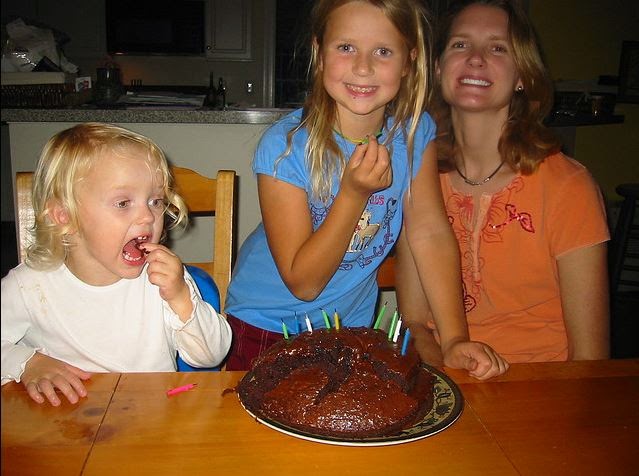If you are a lawyer or you have more than one kid, most certainly you are used to "This is not fair!" statements. "Not fair - he got more dessert," "No fair - why should I do chores if she is enjoying life?" etc etc. Imagine that you have something, like a yummy looking chocolate cake or a pile of chocolate sprinkles, that you need to divide among competing parties while minimizing "not fair" statements. When you have two competing parties - two kids - the solution is well-known. You offer one of them to divide the cake into two parts, and then the other one should pick her/his part first. Now, imagine you have three competing parties. Can you think of a creative strategy to help these parties divide their treasure, so that "no fair" screams will be minimized.
Image via Flickr by terren.
Submit your answer on our Family Puzzle Marathon Be first to solve three puzzles and get a prize! One puzzle per week, please.














9 comments:
I think I'd "number" the parties, ABC. Party A makes the first cut, B makes the second cut. (That's 3 pieces if the cake was already a wedge and these are radial cuts.) C chooses first, B chooses second. That gonna work?
If the cake was circular at the beginning, and if wedges are desired, then we'll need 3 radial cuts. Mom could make the first radial cut (at "noon" o'clock) or A could; let's say A cuts at "noon," B tries to cut near 4, C will try to cut near 8. A to choose first, B choose second. Maybe? Tom
I would have one person (A) split the item into three portions. The other two people (B&C) decide which portions are "fair". If they agree on which portions are fair, then each may take a fair portion, leaving a portion for "A". If "B" thinks portion 1 & 2 are fair, and "C" thinks only portion 1 is fair, then "C" gets 1, "B" gets 2 and "A" gets 3. "B" can't complain because they said 1 and 2 were fair. If B & C have an issue with that, give portion 1 to A since both B & C thought it was fair and combine portions 1 & 2 and re-divide using the B cuts, C chooses method.
Well, let me think about Katrina's solution. Too convoluted for me to visualize at midnight.
Tom - I like your second approach. It just requires placing a clock of a larger radius under the cake or measuring angles. Very creative.
The solution I had in mind is:
A divides the cake into two parts. Doesn't matter what shape the cake is. B chooses one part. A and B now each have half of the cake. Each of them divides his half into three parts. C chooses one part from A and one part from B.
Both, A and B are left with two of the parts they cut.
I had some time to think now about Katrina's solution. It looks like it covers only some of the potential sharing scenarios. What if A cut the cake so that one part is very large and two others are small. Both, B and C, would want the largest part and whoever does not get it screams "Not fair!"
Maria, I like your solution for its simplicity and its fairness.
But A is in the worst position because (assuming B and C choose well), she can at best get her share, and is likely to get somewhat less. If she doesn't cut perfectly, that goes to the benefit of B and/or C. C, who gets to pick "the biggest piece" of each is likely to end up with the most.
I know if this was done in my house which part I would have to play...
I think we can define "fairness" as:
if any person thinks that her piece is smaller than others' pieces she has no one to blame but herself.
In this case if A doesn't split the cake into two equal parts, she is likely to get smaller part at the end and could only blame herself.
But in reality, in my house, this reasoning may still lead to some tears.
Ultimately, the goal of being fair is a good one, but I suppose at some point we all need to learn that life isn't always fair...
Oh well if we can have MANY cuts, that's different and easier. Anybody can cut it into 12 pieces, why not, or 15 or 18,and then the 3 children take turns selecting what they want. Fair enough. Tom
Maria's answer does seem the best to me now. It was never about being EQUAL, only about being optimally "fair." Tom
Post a Comment
Note: Only a member of this blog may post a comment.